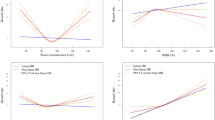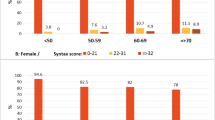Abstract
The objective of this study was to investigate the characteristics of coronary lesions in patients with coronary heart disease complicated with hypertriglyceridemic waist phenotype and determine the relation to risk factors. For this purpose, 105 patients with ≥50 % stenosis in one branch of coronary arteries as confirmed by coronary angiography were enrolled. Further, in this regard, 41 cases (i.e., case group) were complicated with hypertriglyceridemic waist phenotype, while 64 patients (i.e., control group) were not complicated with this phenotype. The data show that, as compared with control group, the patients in case group had higher coronary artery scores. The coronary lesions in case group were associated with waist triglycerides index and tumor necrosis factor (TNF)-α; partial regression coefficients were 0.774 (P < 0.001) and 0.250 (P = 0.001), respectively. Therefore, it was concluded that the patients with hypertriglyceridemic waist phenotype had a worse coronary heart disease condition, whereas waist triglycerides index and TNF-α related closely to the severity of coronary lesions.
Similar content being viewed by others
References
Arsenault, B. J., Lachance, D., Lemieux, I., et al. (2007). Visceral adipose tissue accumulation, cardiorespiratory fitness, and features of the metabolic syndrome. Archives of Internal Medicine, 167, 1518–1525.
Arsenault, B. J., Lemieux, I., Despres, J.-P., et al. (2010). The hypertriglyceridemic waist phenotype and the risk of coronary artery disease: Results from the EPIC-Norfolk prospective population study. Canadian Medical Association Journal, 182, 1427–1432.
Lemieux, I., Poirier, P., Bergeron, J., et al. (2007). Hypertriglyceridemic waist: A useful screening phenotype in preventive cardiology? Canadian Journal of Cardiology, 23(Suppl B), 23B–31B.
Sam, S., Haffner, S., Davidson, M. H., et al. (2009). Hypertriglyceridemic waist phenotype predicts increased visceral fat in subjects with type 2 diabetes. Diabetes Care, 32, 1916–1920.
St-Pierre, J., Lemieux, I., Vohl, M. C., et al. (2002). Contribution of abdominal obesity and hypertriglyceridemia to impaired fasting glucose and coronary artery disease. American Journal of Cardiology, 90, 15–18.
Bardini, G., Dicembrini, I., Pala, L., Cresci, B., & Rotella, C. M. (2011). Hypertriglyceridemic waist phenotype and β-cell function in subjects with normal and impaired glucose tolerance. Diabetic Medicine, 28, 1229–1233.
Lemieux, I., Pascot, A., Couillard, C., et al. (2000). Hypertriglyceridemic waist: A marker of the atherogenic metabolic triad (hyperinsulinemia; hyperapolipoprotein B; small, dense LDL) in men? Circulation, 102, 179–184.
Lamarche, B., Tchernof, A., Mauriège, P., et al. (1998). Fasting insulin and apolipoprotein B levels and low-density lipoprotein particle size as risk factors for ischemic heart disease. The Journal of the American Medical Association, 279, 1955–1961.
Chinese Society of Cardiology. (2011). Editorial board of Chinese journal of cardiology: Chinese prevention guidelines of cardiovascular diseases. Chinese Journal of Cardiology, 39, 3–22.
Xiao-yu, L., Yan, G., Wang-yu, Y., et al. (2003). The relation of small dense low-density lipoprotein and the risk factors to stroke. Zhonghua Yixue Zazhi, 83, 1939–1941.
Fruchart, J. C., Sacks, F. M., Hermans, M. P., et al. (2008). The residual risk reduction initiative: A call to action to reduce residual vascular risk in dyslipidemic patients. A condensed position paper by the residual risk reduction initiative (R3j). Diabetes and Vascular Diseases Research, 5, 319–335.
Taskinen, M. R., Adiels, M., Westerbacka, J., et al. (2011). Dual metabolic defects are required to produce hypertriglyceridemia in obese subjects. Arteriosclerosis, Thrombosis, and Vascular Biology, 31, 1946–1948.
Atar, I. A., Atar, I., Aydınalp, A., et al. (2011). Is there any relationship between coronary artery disease and postprandial triglyceride levels? The Anatolian Journal of Cardiology, 11, 201–206.
Nordestgaard, B. G., Benn, M., Schnohr, P., et al. (2007). Nonfasting triglycerides and risk of myocardial infarction, ischemic heart disease, and death in men and women. The Journal of the American Medical Association, 298, 299–308.
Després, J. P., & Lemieux, I. (2006). Abdominal obesity and metabolic syndrome. Nature, 444, 881–887.
Tanko, L. B., Bagger, Y. Z., Qin, G., et al. (2005). Enlarged waist combined with elevated triglycerides is a strong predictor of accelerated atherogenesis and related cardiovascular mortality in postmenopausal women. Circulation, 111, 1883–1890.
Acknowledgments
The authors thank Kunming Medical Colleges and Yunnan Provincial Science and Technology Department for financial support (Project Code: 2007C0021R).
Author information
Authors and Affiliations
Corresponding author
Rights and permissions
About this article
Cite this article
Yang, Rf., Lin, Z., Liu, Xy. et al. A Clinical Study of Patients with Coronary Heart Disease Complicated with Hypertriglyceridemic Waist Phenotype. Cell Biochem Biophys 70, 289–293 (2014). https://doi.org/10.1007/s12013-014-9906-7
Published:
Issue Date:
DOI: https://doi.org/10.1007/s12013-014-9906-7




